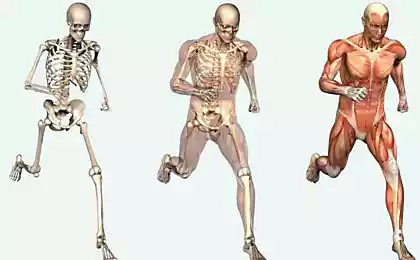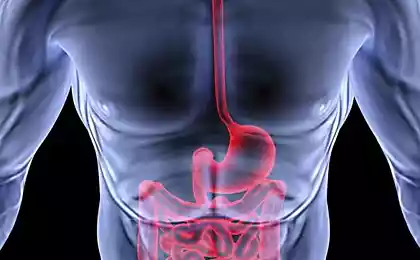692
Where does sea-sickness and how to get rid of it
Undoubtedly, seasickness is a very unpleasant phenomenon. Find out why our body is so sensitive to the monotonous rocking and what can be done.
The pirate ship looked just like in the adventure movies on his nose sported a creepy figure in the form of the head of the Gorgon Medusa, on the mast flying a Jolly Roger, and on Board we were greeted by a double of Jack Sparrow with braiding a beard.
We went to see dolphins off the coast of Tenerife, and my three year old was all excited about this trip, while I was... trying to keep my Breakfast.

Seasickness is one of the worst enemies of vacationers. According to a recent survey, passengers of cruise ships call sea sickness is a major inconvenience of those that they had to endure during the holidays.
Besides, it is difficult to avoid. As said by British comedian spike Milligan, "the only way not to suffer from seasickness is to sit under the tree."
However, many people dream about travelling on the water, leisurely cruises, traveling by boat from island to island or a boat powered only by the wind.
Some try to fight with these terrible feelings, like I did, while others just prefer to have solid ground under my feet.
Seasickness is a form of sickness. Road, sea and air sickness due to physical stimuli, and fitness disease and cyberbulling — visual stimuli, however, all these types of motion sickness characterized by a General mechanism of appearance.
We get motion sickness when the inner ear (or labyrinth) and the Central nervous system can't recognize where is the vertical plane.
Or in other words, when the sense of balance and equilibrium, which meets the inner ear is disturbed by movement — for example, due to rough sea.
However, the main difference between the sea-sickness is that in many cases it lasts a long time.
"Even the worst of travel by bus, car or plane don't last a few days. Yes, the plane may shake, but not for long," says Dr Richard Dawood, specialist in travel medicine at the London clinic, Fleet Street Clinic.
During a trip in the car you can stop and exit. At sea it can only dream of. You think that you are trapped, and this feeling increases the likelihood of seasickness.
Seasickness suffered even famous sailors, including Admiral Nelson, Charles Darwin and Christopher Columbus.
When the English ships of Queen Elizabeth I faced the Invincible Armada, the Spanish Admiral the Duke of Medina Sidonia was seasick. It is believed that this was one of the factors that led to the victory of England.
In Roman times the poet Horace wrote that before sea sickness, everyone is equal: rich and poor.
Beth Leonard, an experienced sea traveler, says that today the pain in varying degrees, felt by many sailors. This usually occurs within the first two to three days each sailing.
Most get used to him for three days no matter what attempts to cope with him being taken.
Leonard interviewed 38 people who love sea travels and found that three-quarters of them suffer from nausea every sea.
Another poll of the magazine Yachting World with the participation of 223 people found that 62% had experienced symptoms of the disease.
These include not only a strong feeling of nausea. As a rule, all begins with milder symptoms, such as yawning or excessive salivation, and then the condition begins to deteriorate.
The man emerges, cold sweats, dizzy and a headache, he feels fatigued, and it all ends with nausea and possibly vomiting.
In the first days at sea, many also complain of problems with concentration.
33% of respondents Beth Leonard complained of drowsiness, quarter — lethargy, the vast majority (79%) — nausea and on vomiting.
In 86% of those who ignored the first signs of sea sickness, the condition worsened, leading to serious vomiting.

However, experienced sailors often have their own tricks that help them quickly deal with sea sickness.
Sebastian Smith is one of them. He often goes to sea with his wife Adele and two young daughters and has written several books on how to fight motion sickness.
"I never understood why it's so different feeling from staying on the deck of the ship, he says. — It is obvious that sea-sickness does not depend on age or strength of man."
"It can also occur suddenly. A person can be in a good mood, feel relaxed, and then his face suddenly changes. Ten minutes later he was lying in a fetal position".
Smith says that in the beginning, too much pain, but as soon as he began to swim for long distances, sea sickness has passed and never returned.
"From my own experience I can say that there is also the psychological aspect, he says. Now I know that even if I will have the first symptoms, I will be able to cope with them. It is an experience, and it is of great importance".
His wife, Adele still suffers from sea-sickness during long trips, usually within one or two first days. When their children were very young, and they did not rocked.
"And, interestingly, everything was in order, and Adele, though, it would seem that everything should be the opposite, because she had to change diapers in a tiny stuffy cabin during pitching".
When children are a little older, they began to suffer from sea sickness. However, now they are at it, always.
"They may feel sick for three days, but then everything suddenly stops, and again they feel great, like an experienced sea wolves".
Smith says thatfor someone the best way to combat sea sickness may become a dream. As a rule, the cabin pitching is felt the least, so even if you are better in the fresh air, don't be afraid to go to the cabin and take a NAP.
However, this does not help everyone, and many have to take medications such as "Stugeron" or "Dramamine". However, Smith warns that any medications you should first try to land, since some of them have a strong sedative effect.
Dawood says that long acting — up to three days — the first thing to try band-aid "Scopoderm" (although patches have side effects, and this must necessarily be a doctor).
"We will discuss in detail with your doctor. From severe vomiting, there is another effective drug prescription ("Ondansetron"). It is not necessary to swallow, just put under the tongue".
Time the medication is also important. One sailor by the name of Andrew Barton interviewed Leonard, he organized a program called Adventure Sailing ("Swimming adventure"), in which several sailing ships regularly plied between Bermuda and the Caribbean sea.
Once, when his fleet consisted of nine vessels with 54 crew members, all of them for three days stuck in Newport because of bad weather. Every evening Barton asked them to take medication against sea sickness, thinking that they will leave the port the next day.

When they set sail, the sea was a strong wind and big waves, but the sea sickness started only one person — the one who didn't follow the advice of Smith.
Experienced sailors are advised to take seasickness medicine for not for a few hours before the trip, but much earlier, at least the night before.
Another recommendation is not to climb to the deck of the ship with a hangover. Smith advises to refrain from taking alcohol at least a couple days before the trip.
If you suddenly feels strange, chew anything, even if you don't want. Perfect dry crackers, fresh fruit and raw vegetables. Someone suggests ginger biscuits and ginger tea.
"And for some reason the oranges," adds Smith.
In addition, three days before the trip to avoid food that ever cause you to have indigestion, especially spicy and fatty foods, and foods high in caffeine, salt and sugar.
If you feel nausea while on high-speed sailing vessel, it is not necessary to lean over the Board, because you risk to fall into the water. Take a bucket or a biodegradable package (such is often used by dog owners).
Since vomiting leads to dehydration, drink plenty of fluidsto replenish moisture loss by the body.
One of the respondents Leonard sailors recommend as best as possible to prepare for the journey: for example, take a supply of easily digestible food for the first five days.
Motion sickness can aggravate strong odors (e.g., diesel fuel), overheating or overcooling of the body, as well as eye fatigue from reading or computer work.
Listening to music or audiobooks does not lead to similar problems.
To get rid of the discomfort, you can look at the horizon.
From the deck, try to keep your balance without holding onto any support. Jelte BOS from the Free University of Amsterdam says it helps the Central nervous system to adapt quickly to new conditions.
When the first symptoms he recommends to drink a carbonated Cola.
If you plan to spend a major holiday in my life on a big cruise liner, most likely, you will be fine even without the ginger drinks.
Passengers of these major resistant vessels seldom complain of sickness, because the movement on them is almost not there.
Oddly enough, but your health could also depend on the shape of the vessel.
Recently, with financial support from EU has implemented a project called "Compass" ("a Rational approach to reduce motion sickness and improve the comfort and safety of passengers in Maritime transport"). Its purpose was to study various types of ships and three critical acceleration (longitudinal, transverse and vertical) affect the motion sickness.
The project found out that sea-sickness cause both horizontal and vertical acceleration. This means that on a passenger vessel with the configuration of the catamaran swayed three times less than single-hull ship.
Because of the acceleration we feel the movement and it becomes bad. Seas causes the ship to move up and down and constantly change speed. According to BOS resulting from this vertical acceleration is the main factor in the emergence of marine diseases.
"Besides, if you are above the center of rotation of the ship, you will move in the transverse and in the longitudinal direction, which will lead to horizontal acceleration and, as consequence, to sea-sickness," he adds.
Another factor influencing the sickness may be the stability of the ship.

Maneuvers of the vessel can be calculated based on his design. Given the weather conditions this gives you the opportunity to predict how much the passengers will be on Board even before the ship will be built.
According to BOS, catamarans in General crenata less than single-hulled vessels — simply because their body is wider.
However, catamarans, usually shorter than single-hull vessels. This means that they no longer rotate on a vertical axis.
"Since the latter effect normally is less than the first, catamarans, passengers are less likely to suffer from seasickness in comparison with single-hulled ships," he says.
Also interesting: a Giant of the environmental ship with solar sails
Find out why get motion sickness in the car and how to avoid it
Barefoot believes that if large cruise ships you don't like and you want to swim by rowing or sailing boats on inland waterways, it is likely that you will be fine.
"People tend to be most sensitive to cyclical movements, repeated approximately every six seconds. When sailing on inland waterways on a small boat for the period of the oscillations is smaller and he has to have a strong influence."
In General, the closer you are to the trees under which was advised to sit spike Milligan, the less likely that you'll get carsick.published
Source: www.bbc.com/russian/vert-fut-37220517
The pirate ship looked just like in the adventure movies on his nose sported a creepy figure in the form of the head of the Gorgon Medusa, on the mast flying a Jolly Roger, and on Board we were greeted by a double of Jack Sparrow with braiding a beard.
We went to see dolphins off the coast of Tenerife, and my three year old was all excited about this trip, while I was... trying to keep my Breakfast.

Seasickness is one of the worst enemies of vacationers. According to a recent survey, passengers of cruise ships call sea sickness is a major inconvenience of those that they had to endure during the holidays.
Besides, it is difficult to avoid. As said by British comedian spike Milligan, "the only way not to suffer from seasickness is to sit under the tree."
However, many people dream about travelling on the water, leisurely cruises, traveling by boat from island to island or a boat powered only by the wind.
Some try to fight with these terrible feelings, like I did, while others just prefer to have solid ground under my feet.
Seasickness is a form of sickness. Road, sea and air sickness due to physical stimuli, and fitness disease and cyberbulling — visual stimuli, however, all these types of motion sickness characterized by a General mechanism of appearance.
We get motion sickness when the inner ear (or labyrinth) and the Central nervous system can't recognize where is the vertical plane.
Or in other words, when the sense of balance and equilibrium, which meets the inner ear is disturbed by movement — for example, due to rough sea.
However, the main difference between the sea-sickness is that in many cases it lasts a long time.
"Even the worst of travel by bus, car or plane don't last a few days. Yes, the plane may shake, but not for long," says Dr Richard Dawood, specialist in travel medicine at the London clinic, Fleet Street Clinic.
During a trip in the car you can stop and exit. At sea it can only dream of. You think that you are trapped, and this feeling increases the likelihood of seasickness.
Seasickness suffered even famous sailors, including Admiral Nelson, Charles Darwin and Christopher Columbus.
When the English ships of Queen Elizabeth I faced the Invincible Armada, the Spanish Admiral the Duke of Medina Sidonia was seasick. It is believed that this was one of the factors that led to the victory of England.
In Roman times the poet Horace wrote that before sea sickness, everyone is equal: rich and poor.
Beth Leonard, an experienced sea traveler, says that today the pain in varying degrees, felt by many sailors. This usually occurs within the first two to three days each sailing.
Most get used to him for three days no matter what attempts to cope with him being taken.
Leonard interviewed 38 people who love sea travels and found that three-quarters of them suffer from nausea every sea.
Another poll of the magazine Yachting World with the participation of 223 people found that 62% had experienced symptoms of the disease.
These include not only a strong feeling of nausea. As a rule, all begins with milder symptoms, such as yawning or excessive salivation, and then the condition begins to deteriorate.
The man emerges, cold sweats, dizzy and a headache, he feels fatigued, and it all ends with nausea and possibly vomiting.
In the first days at sea, many also complain of problems with concentration.
33% of respondents Beth Leonard complained of drowsiness, quarter — lethargy, the vast majority (79%) — nausea and on vomiting.
In 86% of those who ignored the first signs of sea sickness, the condition worsened, leading to serious vomiting.

However, experienced sailors often have their own tricks that help them quickly deal with sea sickness.
Sebastian Smith is one of them. He often goes to sea with his wife Adele and two young daughters and has written several books on how to fight motion sickness.
"I never understood why it's so different feeling from staying on the deck of the ship, he says. — It is obvious that sea-sickness does not depend on age or strength of man."
"It can also occur suddenly. A person can be in a good mood, feel relaxed, and then his face suddenly changes. Ten minutes later he was lying in a fetal position".
Smith says that in the beginning, too much pain, but as soon as he began to swim for long distances, sea sickness has passed and never returned.
"From my own experience I can say that there is also the psychological aspect, he says. Now I know that even if I will have the first symptoms, I will be able to cope with them. It is an experience, and it is of great importance".
His wife, Adele still suffers from sea-sickness during long trips, usually within one or two first days. When their children were very young, and they did not rocked.
"And, interestingly, everything was in order, and Adele, though, it would seem that everything should be the opposite, because she had to change diapers in a tiny stuffy cabin during pitching".
When children are a little older, they began to suffer from sea sickness. However, now they are at it, always.
"They may feel sick for three days, but then everything suddenly stops, and again they feel great, like an experienced sea wolves".
Smith says thatfor someone the best way to combat sea sickness may become a dream. As a rule, the cabin pitching is felt the least, so even if you are better in the fresh air, don't be afraid to go to the cabin and take a NAP.
However, this does not help everyone, and many have to take medications such as "Stugeron" or "Dramamine". However, Smith warns that any medications you should first try to land, since some of them have a strong sedative effect.
Dawood says that long acting — up to three days — the first thing to try band-aid "Scopoderm" (although patches have side effects, and this must necessarily be a doctor).
"We will discuss in detail with your doctor. From severe vomiting, there is another effective drug prescription ("Ondansetron"). It is not necessary to swallow, just put under the tongue".
Time the medication is also important. One sailor by the name of Andrew Barton interviewed Leonard, he organized a program called Adventure Sailing ("Swimming adventure"), in which several sailing ships regularly plied between Bermuda and the Caribbean sea.
Once, when his fleet consisted of nine vessels with 54 crew members, all of them for three days stuck in Newport because of bad weather. Every evening Barton asked them to take medication against sea sickness, thinking that they will leave the port the next day.

When they set sail, the sea was a strong wind and big waves, but the sea sickness started only one person — the one who didn't follow the advice of Smith.
Experienced sailors are advised to take seasickness medicine for not for a few hours before the trip, but much earlier, at least the night before.
Another recommendation is not to climb to the deck of the ship with a hangover. Smith advises to refrain from taking alcohol at least a couple days before the trip.
If you suddenly feels strange, chew anything, even if you don't want. Perfect dry crackers, fresh fruit and raw vegetables. Someone suggests ginger biscuits and ginger tea.
"And for some reason the oranges," adds Smith.
In addition, three days before the trip to avoid food that ever cause you to have indigestion, especially spicy and fatty foods, and foods high in caffeine, salt and sugar.
If you feel nausea while on high-speed sailing vessel, it is not necessary to lean over the Board, because you risk to fall into the water. Take a bucket or a biodegradable package (such is often used by dog owners).
Since vomiting leads to dehydration, drink plenty of fluidsto replenish moisture loss by the body.
One of the respondents Leonard sailors recommend as best as possible to prepare for the journey: for example, take a supply of easily digestible food for the first five days.
Motion sickness can aggravate strong odors (e.g., diesel fuel), overheating or overcooling of the body, as well as eye fatigue from reading or computer work.
Listening to music or audiobooks does not lead to similar problems.
To get rid of the discomfort, you can look at the horizon.
From the deck, try to keep your balance without holding onto any support. Jelte BOS from the Free University of Amsterdam says it helps the Central nervous system to adapt quickly to new conditions.
When the first symptoms he recommends to drink a carbonated Cola.
If you plan to spend a major holiday in my life on a big cruise liner, most likely, you will be fine even without the ginger drinks.
Passengers of these major resistant vessels seldom complain of sickness, because the movement on them is almost not there.
Oddly enough, but your health could also depend on the shape of the vessel.
Recently, with financial support from EU has implemented a project called "Compass" ("a Rational approach to reduce motion sickness and improve the comfort and safety of passengers in Maritime transport"). Its purpose was to study various types of ships and three critical acceleration (longitudinal, transverse and vertical) affect the motion sickness.
The project found out that sea-sickness cause both horizontal and vertical acceleration. This means that on a passenger vessel with the configuration of the catamaran swayed three times less than single-hull ship.
Because of the acceleration we feel the movement and it becomes bad. Seas causes the ship to move up and down and constantly change speed. According to BOS resulting from this vertical acceleration is the main factor in the emergence of marine diseases.
"Besides, if you are above the center of rotation of the ship, you will move in the transverse and in the longitudinal direction, which will lead to horizontal acceleration and, as consequence, to sea-sickness," he adds.
Another factor influencing the sickness may be the stability of the ship.

Maneuvers of the vessel can be calculated based on his design. Given the weather conditions this gives you the opportunity to predict how much the passengers will be on Board even before the ship will be built.
According to BOS, catamarans in General crenata less than single-hulled vessels — simply because their body is wider.
However, catamarans, usually shorter than single-hull vessels. This means that they no longer rotate on a vertical axis.
"Since the latter effect normally is less than the first, catamarans, passengers are less likely to suffer from seasickness in comparison with single-hulled ships," he says.
Also interesting: a Giant of the environmental ship with solar sails
Find out why get motion sickness in the car and how to avoid it
Barefoot believes that if large cruise ships you don't like and you want to swim by rowing or sailing boats on inland waterways, it is likely that you will be fine.
"People tend to be most sensitive to cyclical movements, repeated approximately every six seconds. When sailing on inland waterways on a small boat for the period of the oscillations is smaller and he has to have a strong influence."
In General, the closer you are to the trees under which was advised to sit spike Milligan, the less likely that you'll get carsick.published
Source: www.bbc.com/russian/vert-fut-37220517























